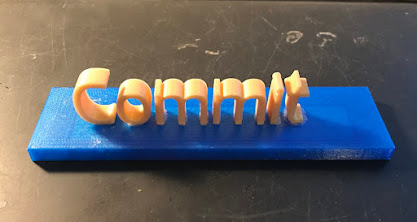As the Vermont Agency of Education once again announced that it was partnering with the Vermont Lottery on an educational technology RFP process, I started to think about the opportunity I had to work with two schools who received this grant to launch projects that focused on learning through creating and making. Being a thought partner with both Brownington School and Montgomery School during their planning stages of their grant project and also helping with the professional development related to the project was a pre-pandemic highlight for me. I miss the opportunities to work directly with students and teachers in their schools. I miss the joy on the faces of learners (young and old) as they move through the stages of inquiry that comes during the process of making.
 |
| Brownington School unpacking new maker tools and supplies from Educate Innovate Grant |
 |
| Montgomery School exploring new maker tools and supplies from Educate/Innovate Grant |
I loved watching the process that these schools went through as they carefully considered WHY they wanted a makerspace in their school and WHAT tools and supplies would best help meet their WHY!
Both groups started by helping their school community EXPLORE the ideas and concepts related to makerspaces. What is a makerspace? Where does CREATING and MAKING fit into the LEARNING process? What does MAKING look like in a classroom? It was a pleasure to be part of that process. Both schools invited EMMA (my mobile maker studio) and I to visit their school and help their school community during what I call the EXPLORE stage in conversations around makerspaces.
I still remember the white knuckled drive that winter, as I filled my mobile studio (EMMA) with maker supplies and drove EMMA through the snow covered back roads of Vermont.
 |
| EXPLORING MAKING as a vehicle for learning at Montgomery School. (January 2019) |
The Explore Stage can provide educators with some of the vocabulary and concepts often found in conversations about makerspaces. An Explore stage event introduces new tools and processes to teachers. Seeing THEIR own students interact with copper tape, circuit boards, and coding can help educators see what a maker mindset can look like in their school as well as introduce them to tools and supplies they might not be familiar with. For example, even though most science teachers have lead experiments with batteries and light bulbs, many of them have not used copper tape or conductive thread or codable LED lights like neo-pixels. The Explore Stage opens up conversations about new possibilities.
 |
| EXPLORING possibilities for Creating, Making, and Learning at Brownington School. (January 2019) |
As educators see evidence of learning and engagement with different materials and processes during an Explore stage event, they are better positioned to ask deeper questions and imagine more possibilities for making in their learning environments.
The Explore stage should get the attention of both your students and staff. It should start the wheels turning and stimulate curiosity.
 |
| Brownington educators explore possibilities with new maker tools during a hands on Professional Development day. |
Schools like Montgomery and Brownington, whose staff and students have participated in some type of Explore stage event, start the grant RFP process with ideas and questions that have surfaced during their Explore stage event. The grant RFP process allows them to focus those ideas, IDENTIFY learning goals that could be well served by having a makerspace in their school, and streamline their search through the many maker education resources available. The next step for each school that applies for a grant, is to IDENTIFY a question for deeper exploration.
For the Montgomery school, that focus was on engaging more student learning through the Nature Trails that are an integral part of their community. For the Brownington school, the focus was on leveraging the engaging properties of music and sound to create a year long, cross-grade level and cross curricular STEAM project promoting collaboration, creativity, and student choice. Each school used the focused inquiry question that they IDENTIFIED to search for information and GATHER resources that might allow them to CREATE a prototype project.
The process to IDENTIFY a focused question, GATHER resources to CREATE a prototype design as part of the grant RFP process was also valuable to several other schools throughout the state. I received calls and emails from several Vermont schools asking about tools and materials and professional development during this time. An RFP process can scaffold schools through the learning that often happens within a guided inquiry. Even if your school is not awarded the grant, the positive outcomes from going through this process makes it a worthwhile endeavor to take on.
What if every school who goes through the RFP process used the focused questions, knowledge, skills, and resources they have worked through and shared it with each other as a way to spread ideas of what's possible.
According to Peter Senge, learning organizations are



























